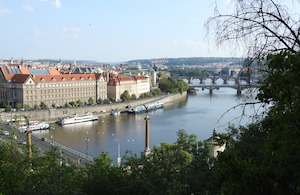 This is ridiculous. The castle in Prague is officially the largest ancient castle in the world, and I can’t find it.
This is ridiculous. The castle in Prague is officially the largest ancient castle in the world, and I can’t find it.
My appalling sense of direction has me disoriented in the narrow cobbled streets below it, where a jumble of squat-fronted shops sell postcards, beer and saucy t-shirts.
Finally, I summit a steep street and there it is, vast, strong and imposing, as castles ought to be. It dates back to the year 800 and has served Bohemian kings, Roman Emperors and now the President of the Czech Republic.
You can explore the grounds without a ticket, but it’s worth the fee to enter its various grand rooms, the on-site cathedral and Long Street, a narrow lane of shop-houses where craftsmen once smelted swords, carved wood and ran bawdy bars.
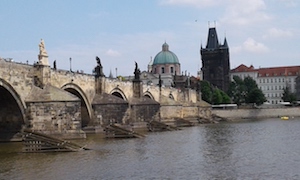 A Czech flag is fluttering on the castle roof, which is a little disappointing. A few years ago, fake chimney sweeps stole the flag and raised a giant pair of red underpants to protest against their government’s support for Russia.
A Czech flag is fluttering on the castle roof, which is a little disappointing. A few years ago, fake chimney sweeps stole the flag and raised a giant pair of red underpants to protest against their government’s support for Russia.
That’s one of the gems I pick up from the cheeky Use-It Map for Young Travellers, a brilliant map to follow even if you’re old. Its quirky comments tickle my sense of humour, like the section that advises: “Naturally there are a shitload of tourist traps here, so remember: Don’t get a Thai massage, don’t buy tickets to a concert on the street, don’t think there is something local about absinth.”
The map led me to some unusual places, like a former slaughterhouse converted into a giant Vietnamese market, and a tiny public boat that crosses the Vitavia River far from any tourist sites.
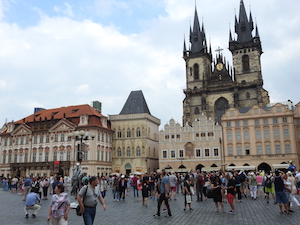 But it’s the historic centre that lures people in, with gorgeous buildings that must have reminded the humble peasants how mighty were their rulers. There’s certainly an aloofness about them, with elegant arches and pillars, balconies and statues, friezes and cupolas. The overall effect in the Old Town Square is astonishing, and every time I cross this historic heart I stop and turn slow circles to take it all in. Most famous is the Old Town Hall, founded in 1338, with its medieval animated Astronomical Clock. It’s kept perfect time for centuries, but was out of action for repairs the week I happened to be there.
But it’s the historic centre that lures people in, with gorgeous buildings that must have reminded the humble peasants how mighty were their rulers. There’s certainly an aloofness about them, with elegant arches and pillars, balconies and statues, friezes and cupolas. The overall effect in the Old Town Square is astonishing, and every time I cross this historic heart I stop and turn slow circles to take it all in. Most famous is the Old Town Hall, founded in 1338, with its medieval animated Astronomical Clock. It’s kept perfect time for centuries, but was out of action for repairs the week I happened to be there.
The square is the meeting point for the free Sandeman’s walking tours, and my guide Karel Wichterle was excellent. He’d studied drama, and delivered his information with a theatrical flourish. Prague has much inbuilt drama anyway, what with the Nazi occupation in the Second World War followed by repressive Russian occupation until the Velvet Revolution in 1989. It took until 1962 to oust the world’s largest statue of Stalin, which stood on a hill in Letná Park until it was blown to smithereens. Now a giant metronome stands there, and I follow a winding path to reach it. At the top I’m delighted to find a stall selling beer and cider, so I buy half a litre and admire the view across the river to the city centre. Prague is full of viewpoints, and there’s usually beer to be had when you reach them.
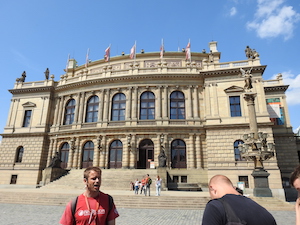 There’s another viewpoint in Petřín Park if you climb the Eiffel Tower. Wrong city, I know, but a good architectural idea is always worth copying. The park also features the fading man sculpture to honour victims of communism, with seven bronze figures gradually losing their substance to fade away.
There’s another viewpoint in Petřín Park if you climb the Eiffel Tower. Wrong city, I know, but a good architectural idea is always worth copying. The park also features the fading man sculpture to honour victims of communism, with seven bronze figures gradually losing their substance to fade away.
Prague’s transport system is brilliant, with one ticket covering the trams, buses and underground trains. Yet you still walk for miles as you explore its ornate streets and stroll the riverbank to view everything from a different angle.
The real downside to Prague is that everyone adores it, so you cross the famous Charles Bridge in a shuffling crush, and you can’t cut through the old town square without bumping into selfie-stick hoards or a crew of levitating mime artists.
So after a week I was happy to catch a bus to Český Krumlov, a pocket-sized Prague two hours to the south. Day-trippers have discovered this beautiful town too, but once the tour groups leave the magic returns.
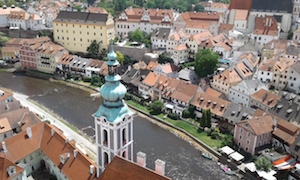 My bus stopped on the outskirts, and I lugged my bags down the cobbled main street under the blazing sun, looking for the rooms I’d rented above a restaurant. The Kristinka Pension looked fabulous, but I obviously didn’t, because the owner instantly led me onto the terrace by the river and poured a welcome glass of wine to cool me down.
My bus stopped on the outskirts, and I lugged my bags down the cobbled main street under the blazing sun, looking for the rooms I’d rented above a restaurant. The Kristinka Pension looked fabulous, but I obviously didn’t, because the owner instantly led me onto the terrace by the river and poured a welcome glass of wine to cool me down.
The building dates back to 1504 when it was a brewery that doubled as a prison, with deep cellars divided into cells. In the 17th century it was turned into a house and witches moved in. They were white witches though, doing good deeds, and I didn’t feel anything going bump in the night.
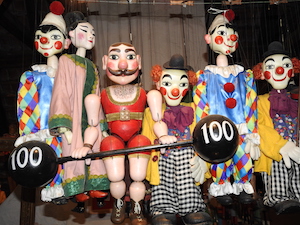 The entire town centre is a Unesco World Heritage site with a glorious castle, picturesque squares, a small marionette museum and bridges across the Vitava River, which has carved out five distinct nobbles of land like interlocking jigsaw pieces. You stroll around thinking the river is behind you, and suddenly it’s in front again.
The entire town centre is a Unesco World Heritage site with a glorious castle, picturesque squares, a small marionette museum and bridges across the Vitava River, which has carved out five distinct nobbles of land like interlocking jigsaw pieces. You stroll around thinking the river is behind you, and suddenly it’s in front again.
The view from the castle’s bell tower is spectacular, looking down on a jumble of terracotta tiles with the river winding through them.
Like Prague, though, charming Český Krumlov is a victim of its own success, with the centre taken over by tourist shops, and the locals moving further out as holiday rentals make property unaffordable.
What a dilemma. You absolutely have to go, but you wish everybody else would stay away.